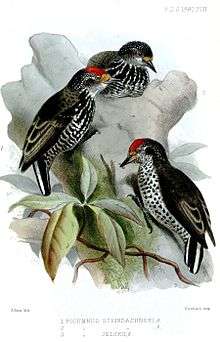Speckle-chested piculet
The speckle-chested piculet (Picumnus steindachneri) is a species of bird in the family Picidae (woodpeckers) endemic to Peru. Its natural habitats are tropical moist lowland and montane forests. It is threatened by habitat destruction as the forests are cleared to make way for agricultural land, and the IUCN has rated it as being an endangered species.
| Speckle-chested piculet | |
|---|---|
 | |
| Male and female speckle-chested piculet (above), male ocellated piculet (below) | |
| Scientific classification | |
| Kingdom: | Animalia |
| Phylum: | Chordata |
| Class: | Aves |
| Order: | Piciformes |
| Family: | Picidae |
| Genus: | Picumnus |
| Species: | P. steindachneri |
| Binomial name | |
| Picumnus steindachneri Taczanowski, 1882 | |
Description
This is a small species growing to a length of 8.5 to 10 cm (3.3 to 3.9 in). It is mainly grey, black and white, the upper parts being greyish-brown speckled and barred with white or buff, the throat being whitish and the breast being black with white tear-drop markings. The flanks and the rest of the underparts are barred in black and white. The tail is blackish apart from the central two feathers and a bar near the tip which are white. The front of the crown in males is red while in females it is black.[2]
Distribution and habitat
The speckle-chested piculet is endemic to Peru. It has a rather limited range, being only known from the central Huallaga Valley and certain parts of the Utcubamba Valley in the foothills of the eastern Andes in Peru. Its altitudinal range is between about 1,100 and 2,200 m (3,600 and 7,200 ft).[1] Its main habitat is primary moist lowland forest and moist montane forest with vines, epiphytes and bamboos, but it also occurs in secondary growth forests, and thickets in cultivated areas.[2]
Ecology
Little is known about the breeding habits of this species. Birds may feed in family groups or in small mixed-species flocks foraging through the canopy, or they may feed alone or in pairs.[3]
Status
P. steindachneri has a small and restricted range. It is generally uncommon, and the total number of mature adults is estimated to be between 6,000 and 15,000 birds; the population is predicted to decline by 50% or more over the next three generations as the natural forest within its range is cleared through logging, to make way for agriculture, coffee plantations and grazing land.[1] The International Union for Conservation of Nature has assessed its conservation status as being endangered.[1] It is an inconspicuous bird, and it is possible that further, unknown populations may exist in remote forests in the area.[2]
References
- BirdLife International (2016). "Picumnus steindachneri". IUCN Red List of Threatened Species. 2016: e.T22680733A92875031. doi:10.2305/IUCN.UK.2016-3.RLTS.T22680733A92875031.en.
- Gorman, Gerard (2014). Woodpeckers of the World: A Photographic Guide. Firefly Books. pp. 62–63. ISBN 177085309X.
- Winkler, H.; Christie, D.A.; Sharpe, C.J. "Speckle-chested Piculet (Picumnus steindachneri)". Handbook of the Birds of the World Alive. Lynx Edicions, Barcelona. Retrieved 22 April 2017.
